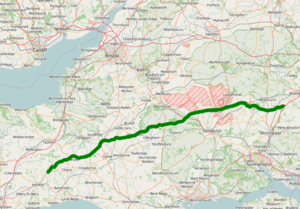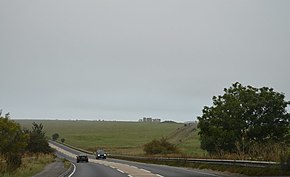 Route of the A303 across southern England | |
 The A303 in Wiltshire, with Stonehenge in the background | |
| Route information | |
| Maintained by National Highways | |
| Length | 93 mi[1] (150 km) |
| History |
|
| Known for | Stonehenge road tunnel (proposed) |
| Major junctions | |
| Northeast end | Basingstoke |
| To | Honiton |
| Location | |
| Country | United Kingdom |
| Counties | Hampshire, Wiltshire, Dorset, Somerset, Devon |
| Primary destinations | Andover Salisbury Warminster Yeovil |
| Road network | |
The A303 is a trunk road in southern England, running between Basingstoke in Hampshire and Honiton in Devon via Stonehenge. Connecting the M3 and the A30, it is part of one of the main routes from London to Devon and Cornwall. It is a primary A road throughout its length, passing through five counties.
The road has evolved from historical routes, some of which are thousands of years old, including the Harrow Way and the Fosse Way. The modern route was first laid out in the early 19th century as the New Direct Road, a faster coaching route from London to Exeter. It was initially in demand but fell into disuse as railways became popular from the 1840s onwards. It was not thought of as a significant through route when roads were initially numbered, but was revived as a major road in 1933, eventually becoming a trunk road in 1958. Since then, the A303 has gradually been upgraded to modern standards, though there are still several unimproved parts with longstanding plans to fix them.
As a primary route to southwestern England, the A303 is frequently congested on its single carriageway sections. It passes through the Stonehenge World Heritage Site and the Blackdown Hills Area of Outstanding Natural Beauty, and attempts to upgrade the road in those areas have been controversial. In particular, the Stonehenge tunnel, which would see the A303 rerouted underground, has been proposed and delayed several times. Nevertheless, the road remains a popular alternative to motorway driving.
- ^ Cite error: The named reference
gmap_endwas invoked but never defined (see the help page). - ^ Travis, John F (1993). The Rise of the Devon Seaside Resorts, 1750–1900. University of Exeter Press. p. 64. ISBN 978-0-859-89392-3.

